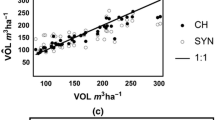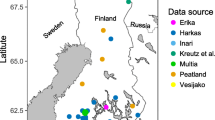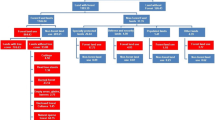Abstract
The Norwegian National Forest Inventory (NNFI) provides estimates of forest parameters on national and regional scales by means of a systematic network of permanent sample plots. One of the biggest challenges for the NNFI is the interest in forest attribute information for small sub-populations such as municipalities or protected areas. Frequently, too few sampled observations are available for such small areas to allow estimates with acceptable precision. However, if an auxiliary variable exists that is correlated with the variable of interest, small area estimation (SAE) techniques may provide means to improve the precision of estimates. The study aimed at estimating the mean above-ground forest biomass for small areas with high precision and accuracy, using SAE techniques. For this purpose, the simple random sampling (SRS) estimator, the generalized regression (GREG) estimator, and the unit-level empirical best linear unbiased prediction (EBLUP) estimator were compared. Mean canopy height obtained from a photogrammetric canopy height model (CHM) was the auxiliary variable available for every population element. The small areas were 14 municipalities within a 2,184 km2 study area for which an estimate of the mean forest biomass was sought. The municipalities were between 31 and 527 km2 and contained 1–35 NNFI sample plots located within forest. The mean canopy height obtained from the CHM was found to have a strong linear correlation with forest biomass. Both the SRS estimator and the GREG estimator result in unstable estimates if they are based on too few observations. Although this is not the case for the EBLUP estimator, the estimators were only compared for municipalities with more than five sample plots. The SRS resulted in the highest standard errors in all municipalities. Whereas the GREG and EBLUP standard errors were similar for small areas with many sample plots, the EBLUP standard error was usually smaller than the GREG standard error. The difference between the EBLUP and GREG standard error increased with a decreasing number of sample plots within the small area. The EBLUP estimates of mean forest biomass within the municipalities ranged between 95.01 and 153.76 Mg ha−1, with standard errors between 8.20 and 12.84 Mg ha−1.





Similar content being viewed by others
Notes
Global Positioning System
Global Navigation Satellite System
Next Generation Automatic Terrain Extraction.
Due to different methods of deriving the estimators, there actually exist two area-specific MSE estimators. An alternative to the MSE estimator (13) is \(\widehat{{\rm MSE}}_{\bar{Y}_{E,i}} = C_{1,i} + C_{2,i} + 2 C^*_{3,i}\). In a pre-evaluation, both estimators gave approximately the same results. The one that frequently resulted in slightly higher MSEs is given in the main text.
References
Andersen HE, Breidenbach J (2007) Statistical properties of mean stand biomass estimators in a lidar-based double sampling forest survey. Vol. 36 of IAPRS: Proceedings of the ISPRS Workshop on Laser Scanning, SilviLaser 2007, pp 8–13
Arnevik LI (2011) Landsdekkende digital terrengmodell med 10 eller 20 meters rutenett. Tech. Rep., Statens Kartverk.
BAE Systems (2008) SocetSet. Tech. Rep., BAE Systems
Baltsavias E (1999) A comparison between photogrammetry and laser scanning. ISPRS J Photogramm Remote Sens 54(2–3):83–94
Baltsavias E, Gruen A, Eisenbeiss H, Zhang L, Waser LT (2008) High-quality image matching and automated generation of 3D tree models. Int J Remote Sens 29(5):1243–1259
Battese G, Fuller W (1981) Prediction of county crop areas using survey and satellite data. In: Proceedings of the section on survey research methods, American Statistical Association, pp 500–505
Battese GE, Harter RM, Fuller WA (1988) An error-components model for prediction of county crop areas using survey and satellite data. J Am Stat Assoc 83(401):28–36
Bjørdal I, Bjørkelo K (2006) AR5 Klassifikasjonssystem, Klassifikasjon av arealressurser, Håndbok fra Skog og landskap. Tech. Rep., Skog og landskap
Breidenbach J (2011a) Comparison of a photogrammetric canopy height model (CHM) with a LiDAR derived CHM in Vestfold county. In: Breidenbach J, Astrup R (eds) Proceedings of the seminar “Creation of digital elevation models from aerial images for forest monitoring purposes”, 9 June 2011, Ås, Norway. The Norwegian forest and lanscape institute, pp 1–4
Breidenbach J (2011b) JoSAE: functions for unit-level small area estimators and their variances. R package version 0.2. http://cran.us.r-project.org/web/packages/JoSAE/
Breidenbach J, Kublin E, McGaughey R, Andersen H-E, Reutebuch S (2008) Mixed-effects models for estimating stand volume by means of small footprint airborne laser scanner data. Photogramm J Finl 21(1):4–15
Breidenbach J, Næsset E, Lien V, Gobakken T, Solberg S (2010) Prediction of species specific forest inventory attributes using a nonparametric semi-individual tree crown approach based on fused airborne laser scanning and multispectral data. Remote Sens Environ 114(4):911–924
Breidenbach J, Nothdurft A, Kändler G (2010) Comparison of nearest neighbour approaches for small area estimation of tree species-specific forest inventory attributes in central Europe using airborne laser scanner data. Eur J Forest Res 129(5):833–846
Eriksen R, Tomter S, Ludahl A (2006) Statistikk over skogforhold og -ressurser i Vestfold, Landsskogtakseringen 2000–2004. NIJOS-ressursoversikt (ISBN 82-7464-368-2) 03/06, Norsk institutt for jord- og skogkartlegging, Ås, Norway
Flores L, Martınez L (2000) Land cover estimation in small areas using ground survey and remote sensing. Remote Sens Environ, Elsevier 74:240–248
Gallego FJ (2004) Remote sensing and land cover area estimation. Int J Remote Sens 25:3019–3047
Gjertsen AK (2007) Accuracy of forest mapping based on landsat TM data and a kNN-based method. Remote Sens Environ 110(4):420–430
Goerndt ME, Monleon VJ, Temesgen H (2011) A comparison of small-area estimation techniques to estimate selected stand attributes using lidar-derived auxiliary variables. Can J For Res 41(6):1189–1201
Gregoire T (1998) Design-based and model-based inference in survey sampling: appreciating the difference. Can J For Res 28(10):1429–1447
Grubner M, Kröpfl M (2007) Calibaration report, UltraCamX, SNo: UCX-SX-1-70717171. Tech. Rep., Microsoft, Vexcel Imaging, Graz, Austria
Henderson C (1950) Estimation of genetic parameters. Biometrics 6:186–187
Heurich M (2007) Evaluierung und Entwicklung von Methoden zur automatisierten Erfassung von Waldstrukturen aus Daten flugzeuggetragener Fernerkundungssensoren. PhD thesis, Technische Universität München
Hirschmugl M, Ofner M, Raggam J, Schardt M (2007) Single tree detection in very high resolution remote sensing data. Remote Sens Environ 110(4):533–544
Hyyppä J, Inkinen M (1999) Detecting and estimating attributes for single trees using laser scanner. Photogramm J Finl 16(2):27–42
Hyyppä J, Hyyppä H, Leckie D, Gougeon F, Yu X, Maltamo M (2008) Review of methods of small-footprint airborne laser scanning for extracting forest inventory data in boreal forests. Int J Remote Sens 29(5):1339–1366
Köhl M, Magnussen S, Marchetti M (2006) Sampling methods, remote sensing and GIS multiresource forest inventory. Springer, Berlin
Landsskogtakseringen (2008) Landsskogtakseringens feltinstruks 2008, Hsndbok fra Skog og landskap 05/08. Skog og landskap, Ås, Norway
Leberl F, Irschara A, Pock T, Meixner P, Gruber M, Scholz S, Wiechert A (2010) Point clouds: Lidar versus 3d vision. Photogramm Eng Remote Sens 76(10):1123–1134
Marklund L (1988) Biomass functions for pine, spruce and birch in sweden. Institutionen foer Skogstaxering, Sweden
McGaughey R (2008) Fusion manual version 2.70. Tech. rep., USDA, Pacific North-West Research Center, Seattle, WA
McRoberts R, Tomppo E (2007) Remote sensing support for national forest inventories. Remote Sens Environ 110(4):412–419
McRoberts RE, Cohen WB, Næsset E, Stehman SV, Tomppo EO (2010) Using remotely sensed data to construct and assess forest attribute maps and related spatial products. Scand J For Res 25(4):340–367
McRoberts RE, Tomppo EO, Næsset E (2010) Advances and emerging issues in national forest inventories. Scand J For Res 25(4):368–381
Means J, Acker S, Fitt B, Renslow M, Emerson L, Hendrix C (2000) Predicting forest stand characteristics with airborne scanning lidar. Photogramm Eng Remote Sens 66(11):1367–1371
Moe H (2007) Rapport fråaerotriangulering, Vestfold 20 cm 2007, flyoppgåve 13466 (TerraTec 3627). Tech. Rep., TerraTec
Næsset E (1997) Estimating timber volume of forest stands using airborne laser scanner data. Remote Sens Environ 61(2):246–253
Næsset E (2001) Effects of differential single-and dual-frequency gps and glonass observations on point accuracy under forest canopies. Photogramm Eng Remote Sens 67(9):1021–1026
Næsset E (2002a) Determination of mean tree height of forest stands by digital photogrammetry. Scand J For Res 17(5):446–459
Næsset E (2002b) Predicting forest stand characteristics with airborne scanning laser using a practical two-stage procedure and field data. Remote Sens Environ 80(1):88–99
Næsset E, Gobakken T, Solberg S, Gregoire T, Nelson R, Ståhl G, Weydahl D (in press) Model-assisted regional forest biomass estimation using lidar and insar as auxiliary data: A case study from a boreal forest area. Remote Sens Environ
Nothdurft A, Saborowski J, Breidenbach J (2009) Spatial prediction of forest stand variables. Eur J Forest Res 128(3):241–251
Packalén P, Maltamo M (2007) The k-MSN method for the prediction of species-specific stand attributes using airborne laser scanning and aerial photographs. Remote Sens Environ 109(3):328–341
Packalén P, Maltamo M (2008) Estimation of species-specific diameter distributions using airborne laser scanning and aerial photographs. Can J For Res 38(7):1750–1760
Pinheiro J, Bates D (2002) Mixed-effects models in S and S-plus. Springer, Berlin
Prasad N, Rao J (1990) The estimation of the mean squared error of small-area estimators. J Am Stat Assoc 85:163–171
Rao JNK (2003) Small area estimation. Wiley-Interscience, NY
R Development Core Team (2010) R: a language and environment for statistical computing
Royston JP (1982) An extension of Shapiro and Wilk’s W test for normality to large samples. J R Stat Soc. Ser C (Appl Stat) 31(2):115–124
Särndal C (1984) Design-consistent versus model-dependent estimation for small domains. J Am Stat Assoc 79(378):624–631
Särndal C, Swensson B, Wretman J (2003) Model assisted survey sampling. Springer, Berlin
Shapiro S, Wilk M (1965) An analysis of variance test for normality (complete samples). Biometrika 52(3/4):591–611
Straub C, Seitz R (2011) Möglichkeiten der automatisierten Generierung von OberflSchenmodellen in Waldgebieten aus digitalen Luftbildern. Proceedings of the DGPF conference 2011. DGPF, Mainz, Germany
Thompson S (2002) Sampling, second edition Edition. Wiley-Interscience, NY
Tomter S, Hylen G, Nilsen J-E (2010) Norways national forest inventory. In: Tomppo E, Gschwantner T, Lawrence M, McRoberts RE (Eds.): National forest inventories: pathways for common reporting. Springer, Berlin.
Waser LT, Baltsavias E, Ecker K, Eisenbeiss H, Feldmeyer-Christe E, Ginzler C, Küchler M, Zhang L (2008) Assessing changes of forest area and shrub encroachment in a mire ecosystem using digital surface models and CIR aerial images. Remote Sens Environ 112(5):1956–1968
Acknowledgments
We very much appreciate the helpful comments of Dr Edgar Kublin (Forest Research Institute of Baden-Württemberg, Freiburg, Germany), Dr Holger Lange (Norwegian Forest and Landscape Institute, Ås, Norway) and, Dr Ronald E. McRoberts (Northern Research Station, St. Paul, USA) on an early version of the manuscript. We would like to thank two anonymous reviewers for their suggestions, which helped to improve the manuscript.
Author information
Authors and Affiliations
Corresponding author
Additional information
Communicated by A. Weiskittel.
Appendix
Appendix
Asymptotic variances and covariances
The asymptotic variances and covariances \(\bar{V}\) of \(\hat{\sigma}^2_\varepsilon\) and \(\hat{\sigma}^2_\upsilon\) are elements of the inverse of the information matrix M (Rao 2003, p. 140):
The information matrix M is given by
and
with
Rights and permissions
About this article
Cite this article
Breidenbach, J., Astrup, R. Small area estimation of forest attributes in the Norwegian National Forest Inventory. Eur J Forest Res 131, 1255–1267 (2012). https://doi.org/10.1007/s10342-012-0596-7
Received:
Revised:
Accepted:
Published:
Issue Date:
DOI: https://doi.org/10.1007/s10342-012-0596-7




